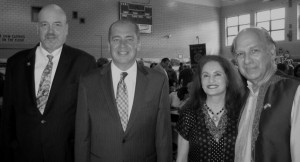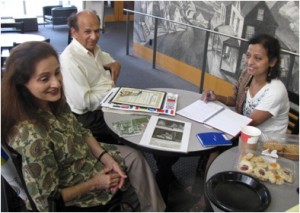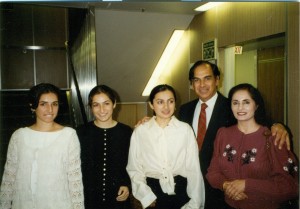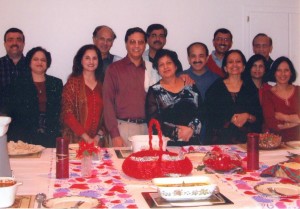Reviving Weirton’s Festival of Nations
By Nandini Mandal      e-mail:  nandini@nandanik.com
Note: Nandini Mandal, the artistic director of Nandanik Dance Academy, recently spoke to Juginder and Dolly Luthra of Weirton, WV, on their participation in reviving Weirton’s Festival of Nations, last held in 1944. She met the Luthras at CMU.
Their story started as a Bollywood-style romance. From the forced migration during India’s painful Partition in 1947, to fifty years later, reviving a defunct Festival of Nations in Weirton, WV, through organizing an Indian Cultural Day there. And their story still continues.
He was born in Multan, in Pakistan now. His family, like other millions, was uprooted during the 1947 Partition and settled down in Panipat, in today’s Haryana, India. Seventh child in the family, he joined the medical school in Amritsar in 1961, obeying his father’s decision.
Three years later, a lovely young lady joined the same medical school in dentistry. Originally from Bombay, she moved to Chandigarh as her father was part of Le Corbusier’s architectural team that built Chandigarh. At the college social, they were part of the play together, with the lovely woman getting the best actress prize. He, Juginder, was in his third year, and she, Dolly, was in her first. And the rest was their destiny together.
Juginder and Dolly were married in 1968, and they moved to the U.K. in 1974 with their first daughter Namita. Juginder Luthra, an ophthalmologist, got his advance diploma in UK. Soon after, their twin baby girls, Rohini and Rashmi, arrived. The Luthras eventually wanted to reach the US shores.
With America still recovering from the Vietnam War, there was a dearth of qualified and experienced doctors in many cities, including Weirton, WV. One of his friends already in Weirton asked him to come to Weirton to practice medicine. In 1975, the Luthras arrived at Weirton with their three daughters.
While Dolly stayed home for eight years to raise their daughters before starting her dentistry practice, Juginder worked as a house physician at the Weirton Medical Center. Weirton was now their home away from home. Juginder recalls, “Our neighbors embraced us, giving us car rides, taught us driving in our very early days as immigrants.â€
To find out how this Punjab da puttar (son of Punjab) became intertwined with the heart and soul of Weirton decades later, we need to understand Weirton’s history built around steel. The economy of Weirton (population 30,000 at its peak) was driven by the steel mill with 13,000 employees at its peak.
In 1909, Ernest T. Weir established a Tin Plate Mill near Holliday’s Cove, a farming village, calling it Weirton, an unincorporated company town. With the expanding mill and an influx of European immigrants, Weirton was incorporated in 1947 by merging several neighboring communities around the mill.
As is the case with all steel towns in the US, Russian, Polish, Greek, Slavic, Italian, Finnish, Hungarian, Welsh, Dutch, Spanish immigrants, and native African-Americans flocked to Weirton in the early 20th century. The interactions among the disparate immigrant groups were not always smooth. A large number of immigrants living in close proximity in a small, isolated town without a strong common American identity was a cause for concern for leaders of the community.
So, in 1934 Weirton’s civic and business leaders conceived a Festival of Nations to foster a sense of fellowship and social and cultural interactions among the ethnic groups. They wanted to showcase the diverse culture in a noncompetitive atmosphere. They succeeded in their mission, and until 1939, the Festival of Nations continued in this spirit with ten nationality groups’ participation in the thousands.
Then World War II started in 1939, ending in 1945. The returning victorious soldiers and the people at large were forged with a common American identity. With this, the rationale for the Festival of Nations too ended, the last one was in 1944.
Good times roared for decades. But with steel’s decline in the 70s, Weirton was devastated like other US towns built around steel. Today Weirton’s population is only 19,000, with only 1000 in steel! Weirton is a now a bedroom community to people working in Robinson Township and the Airport areas.
Flash forward to 2006. The Luthras, now well-established in Weirton, and both ardent art lovers and patrons, decided to showcase India’s dance and musical extravaganza to the people of Weirton. They dipped into the Indian talent in Pittsburgh with artistes trained in India’s rich musical and dance traditions. Sponsored by the Weirton Area Museum and Cultural Center, the Luthras organized the event with Nandanik Dance Academy, Nidrita and Asish Sinha, and Sushanta Banerjee performing in an hour-long program. It was a hit with the audience.
Impressed by the event, Weirton Mayor William Miller, surprised the Luthras by declaring November 18, 2006 “India Heritage Day†in Weirton. The Luthras, now members of the Board of Directors for the Weirton Area Museum and Cultural Center, added a new dimension to Weirton’s cultural landscape.
Then came the Weirton’s centennial in 2009. In a meeting participated by Weirton’s civic and business leaders and community organizers, old-timers wanted to revive the Festival of Nations. Juginder says, “Many of us, including those who have lived here for a long time, had never heard of it before. When they heard about the festival from old-timers, everyone asked me, ‘Why don’t we create something like you did on India?’â€
Weirton’s glorious legacy, now seen through faded photographs and recalled by elders helped in its revival in 2009. The Luthras were active –- for three years, they were the chair and co-chair of the organizing committee — trying to reconnect to Weirton’s past with help from countless citizens of Weirton.
The Festival of Nations was re-started in 2009 with a parade, all singing We are the World at the Municipal Building, with artistes from Weirton and its extended neighborhood including Pittsburgh participating
Every year, attendance improved, starting from mere 400 to over 1600 people this year with twenty-one ethnic groups participating. Indians, Chinese, Koreans, and Japanese are the new entrants. People come back to participate in the parade, buy artifacts from display tables, and taste the featured multiethnic food. The Luthras made sure the gala started with an invocatory piece by Dell Fryer, or Chief White Panther, a Delaware Native American chief.
Now having acquired a building for the museum with a grant of $30,000 from the J.C. Williams foundation, the Luthras and their fellow townsmen are pleased that they were able to revive the Festival of Nations. While recognizing that the festival had seen better days in the past, they hope that it will grow in the years ahead.
Dolly Luthra says, “When my father, a PWD (Public Works Department) engineer, was part of the team that built Chandigarh in India, little did I know that decades later, I will be involved in trying to rebuild another city not physically, but culturally, far away from India. That is very satisfying to me.â€

L ro R: Dennis Jones, President, Weirton Area Museum and Cultural Center; Gov. Earl Ray Tomblin of West Virginia; and Dolly and Juginder Luthra.
The Luthras are also path breakers in other ways. They are the founding members of Triveni, a cultural organization with Bangladeshi, Indian, Pakistani members to share the common ethos of the Indian subcontinent. Under the Triveni banner, in 2010 the Luthras were instrumental in showcasing the creativity of visual artists among Indians in the Pittsburgh Metro area under one roof in Monroeville to display their works.
Soft-spoken and warm, the Luthra’s dedication to Weirton that has seen better days is admirable. The Luthras went forward with the limited resources they had.
Along the way, in their efforts to rebuild the Weirton’s glorious legacy, they have befriended a diverse cross section of people in the community. Weiron too, has embraced them even tighter than before.





